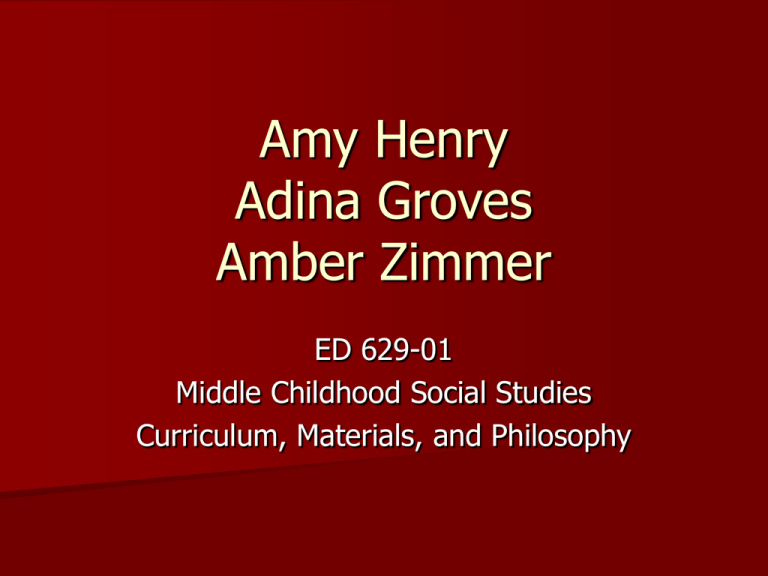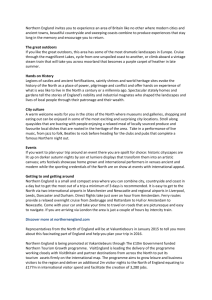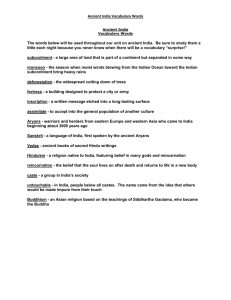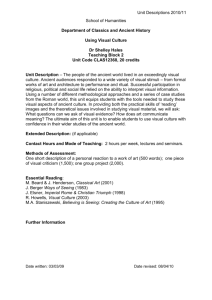Amy Henry Adina Groves Amber Zimmer
advertisement

Amy Henry Adina Groves Amber Zimmer ED 629-01 Middle Childhood Social Studies Curriculum, Materials, and Philosophy Social Studies Technology Project A Social Studies Lesson People in Society: The Fort Ancient People Grade Four Benchmark: People in Society Culture: #1. Describe the cultural practices and products of various groups who have settled in Ohio over time: a. The Paleo Indians, Archiac Indians, Woodland Indians (Adena and Hopewell) and Late Prehistoric Indians (Fort Ancient) Unit Studying the culture of the Late Prehistoric Indians known as the Fort Ancient people How long? 2 weeks Where? Sunwatch & classroom Content Students will be studying the Fort Ancient peoples through classroom work and field experiences at Sunwatch Village in Dayton, Ohio in order to meet objectives. Vocabulary –beans calendar corn daub Fort Ancient hearth post hole prairie solar squash sunflower SunWatch thatch Objective Students will describe the cultural practices and products of the Fort Ancient people who settled in Ohio over time Students will learn the objective through their experiences at SunWatch Indian Village in Dayton, Ohio. Materials: Notebook for recording data Pen or pencil *Additional materials are listed for each student activity. Our Trip to Sunwatch Our Trip to Sunwatch Watching the Video! Our Trip to Sunwatch Matt and a Fort Ancient Chief Our Trip to Sunwatch Ancient Vegetation (that is still around today). Our Trip to Sunwatch Our Trip to Sunwatch Wooden Pole, which used the sunlight to indicate time/seasons. This is how the group became labeled “Sunwatch” Our Trip to Sunwatch Gravesite of a respected member of the Sunwatch community. The gravesites of the important members were covered in limestone. Our Trip to Sunwatch Inside one of the homes Our Trip to Sunwatch Our Trip to Sunwatch Inside the Big House Our Trip to Sunwatch Our Trip to Sunwatch Playing a game that simulated hunting prey. Spear the Rock! Our Trip to Sunwatch Student Activities Next we will discuss a number of activities that may be used for students to effectively learn the objective. Student Activity: Getting ready for the field trip Students will complete the word search on www.sunwatch.org under the activities section. Then once the search is complete, students will define all 13 terms. This word search is used as a starter activity in order to make sure students are familiar with the terms that they will hear and discuss on their field trip to SunWatch. SunWatch Discovery Tour Students will take a guided tour of SunWatch village and learn the culture of the Fort Ancients. Students will be expected to take notes on the material presented. Materials for SunWatch Discovery Tour Notebook to record information Pen or pencil Camera (optional) Lifestyles of the Rich and Prehistoric Students will learn the culture and lifeways of the four different cultural periods of prehistoric Ohio. The main focus will be on the Fort Ancients, but other groups will also be discussed. Materials for Lifestyles of the Rich and Prehistoric Notebook to record data Pen or pencil Scavenger Hunt Students will participate in a scavenger hunt throughout the SunWatch village. The items that the students will recover are products and hints to cultural practices of the Fort Ancients. Materials for Scavenger Hunt Notebook to record discovered items Pen or pencil Camera (optional) Archaeological Field Work Students will use tools to dig up mysteries of the past Fort Ancient people. Students will discover cultural practices and products through their archaeological dig. Additional Activities for the Archaeological Field Work Students will make a prediction before they begin the dig. The prediction will be based on what they are expecting to discover using the knowledge gained during the previous activities. Students will record all data during their field work. Students will finally explain what practices and products they discovered throughout their field work in their notebook and orally. Materials for Archaeological Field Work Notebook to make predictions, report data, and explain final discoveries Pen or pencil Tool for digging will be provided SunWatch Movie After the field trip, students will watch the SunWatch movie from www.archaelogychannel.org and make comparison from the movie and what they saw first hand on the trip. Interactive Sunwatch Village Game Students will go to the website, SunWatch Indian Village Circa 1200 AD, and play the interactive game that explains more about life at Sunwatch in 1200 AD. Interactive Sunwatch Village Game Materials Computer with internet access for groups of students or each student. Archeology and Record Keeping Students will become archeologists in this activity! In partners they will find artifacts laid out on grid paper at multiple stations and be asked to accurately describe where the artifact was found. The students rotate stations and at the second station groups need to place the artifact in the exact location it was originally in based on the previous groups’ description. Student then check to see how close they actually were. Repeat this activity at least one more time so students learn how to document found artifact as real archeologists do. Archeology and Record Keeping Materials Pen Paper Grid Paper (5-6 sheets, depending on group size) Artifacts (5-6, depending on the size of groups) Key of where artifacts are originally planted WebQuest about Ancient Peoples in America An Ancient People From Your Hometown: Who Were They?: Introduction Adapt WebQuest for the Fort Ancient People. This activity asks students to research the Fort Ancient people and create a PowerPoint presenting the research. WebQuest about Ancient Peoples in America Materials Computer access for students with Microsoft PowerPoint and internet access. Research materials (books, encyclopedias, articles, etc) Critique of Sunwatch Field Trip Activity Have students write a critique/review of their trip to Sunwatch. Ask them probing questions. Is Sunwatch worth the trip? What was the best part? What did you learn? What questions do you still have? What do you want to research more about? What didn’t you like? What could have been better? A great interdisciplinary unit with Language Arts. Critique of Sunwatch Field Trip Activity Materials Paper Pens Brainstorming Sheets Thank-You Letter to Guide at Sunwatch Activity Another tie-in with Language Arts! Have you students express thanks to the Sunwatch staff. Prompt students to make this personalized by including specific parts of the trip that they enjoyed. Thank-You Letter to Guide at Sunwatch Activity Materials Paper Pen Thank-You Cards Format for Thank-You Card Stamps (in not delivered by hand) Evaluation 5 MC- 1. Who were the Fort Ancient people? A. aliens from Hunrunft B. Native Americans C. English Settlers D. Mexican Fort Builders. 2. How old is SunWatch village? A. 100 years B. 12,000 years C. 800 D. 8,000 3. What was the big house used for? A. raising children B. jail C. storing corn D. town meetings 4. How did they know when to plant their crops? A. dad told them B. marked on calendar C. shadows of the poles from the sun D. after the snow melted 5. What did limestone in the ground mark? A. the villagers B. animals C. trash pits D. important members graves Answers: 1. b 2. c 3. d 4. c 5. d Evaluation T or F: There was a woman buried with the important people of the village. T or F: Fort Ancient people grew corn and squash. Answers: 1. T 2. T Short Essay: 1. How did the SunWatch village get its name? 2. Where did the men live when they married? Why? Resources Teacher- 1. Fort Ancient Cultural Dynamics in the Middle Ohio Valley (Monographs in World Archaeology, No. 8) (Paperback) by A. Gwynn Henderson (Editor) 2. 3. The Adena, Hopewell, and Fort Ancient of Ohio (Library Binding) by Greg Roza (Author) The Ceramics from the Kramer Village Site by Kyle L. Ullman and Oriol Pi Sunyer (Paperback - Jul 1985) 4. 5. The View from Madisonville: Protohistoric Western Fort Ancient Interaction Patterns by Penelope B. Drooker (Paperback - Jun 1997) The Moundbuilders:Ancient Peoples of Eastern North America (Ancient Peoples and Places) by George R. Milner, Thames, Hudson Student Resources FOCUS ON U.S. HISTORY A set of abundantly illustrated activity books spotlights major eras in American history from the Age of Exploration through Reconstruction. Each book presents a unit overview, objectives, and activities ... more>>> Reproducibles NATIVE PEOPLES OF THE AMERICAS The rich variety of cultures among North American Indian groups can be introduced with the help of these reproducible activity books. Through readings (what did the False Face Society do?), crafts projects ... more>>> Reproducibles NORTH AMERICAN INDIAN: Eyewitness Books By David Murdoch. From pueblo dwellers to Inuit hunters, discover the rich cultures of North American Indians. Stunning full-color photographs offer unique "eyewitness" views: see a Cheyenne ... more>>> Books Resources Blood, Charles L. The Goat in the Rug. Geraldine, a goat, describes how she and a Navajo friend make a rug, from hair clipping to weaving. Bunting, Eve. Cheyenne Again. A Cheyenne boy named Young Bull is taken to a boarding school to learn the white man's ways. Goble, Paul. Death of the Iron Horse. In 1867, a group of young Cheyenne men derail and raid a freight train. Lacapa, Kathleen and Michael. Less Than Half, More Than Whole. A child who is only part Native American is troubled by his mixed racial heritage. Lyon, George Ella. Dreamplace. Present-day visitors describe what they see when they visit the pueblos where the Anasazi lived long ago. Martin, Bill. Knots on a Counting Rope. Boy-Strength-of-Blue-Horses and his grandfather reminisce about the young boy's life. Mitchell, Barbara. Red Bird. Katie, also known as Red Bird, joins her family at the annual powwow in southern Delaware. Nez, Redwing T. Forbidden Talent. Ashkii finds that his way of painting is in conflict with what his grandfather calls the "Navajo Way." Raczek, Linda Theresa. The Night the Grandfathers Danced. When the boys run away at the Bear Dance, Autumn picks a partner from the old men of the tribe. Stroud, Virginia. Doesn't Fall Off His Horse. Grandfather earned his name as a young man when he was wounded in a Kiowa raid on Comanches. Weisman, Joan. The Storyteller. New to the city, a Pueblo girl finds a friend in an elderly neighbor with whom she shares stories. Yolen, Jane. Encounter. A Taino boy on the island of San Salvador recounts the landing of Columbus and his men in 1492. Resources Chapter Books Bruchac, Joseph. Children of the Longhouse. Ohkwa'ri and his twin sister must make peace with a hostile gang of boys in their Mohawk village. Dorris, Michael. Morning Girl. Morning Girl witnesses the arrival of the first Europeans to her island. Durrant, Lynda. Echohawk. A white boy, adopted and raised by Mohicans in the 1730's, is sent to an English settlement for schooling. George, Jean Craighead. Julie of the Wolves. An Eskimo girl who becomes lost on the North Slope of Alaska is befriended by a pack of wolves. Hamilton, Virginia. Arilla Sun Down. A half black and half Indian girl lives in a small town, where life centers on family, school, and friends. Hamm, Diane Johnston. Daughter of Suqua. In the early 1900s, Ida Bowen worries about what is ahead for the Suquamish. Hill, Kirkpatrick. Winter Camp. Toughboy and his younger sister must survive the harsh Alaskan winter at a friend's winter trapping camp. Hobbs, Will. Far North. Gabe and his Dene Friend, Raymond, struggle to survive in the wilderness of the Northwest Territories. Keehn, Sally M. I Am Regina. Kidnapped by Indians, Regina grows up with the name Tskinnak and starts to become Indian. Mead, Alice. Crossing the Starlight Bridge. Rayanne's father leaves and she has to move off the Penobscot reservation to live with her grandmother. O'Dell, Scott. Streams to the River, River to the Sea. Sacagawea experiences joy and heartbreak after joining the Lewis and Clark expedition to the Pacific. O'Dell, Scott. Thunder Rolling in the Mountains. Chief Joseph's daughter tells how her people were driven off their land and forced to flee north. . Resources Rinaldi, Ann. The Second Bend in the River. Rebecca meets Tecumseh in the Ohio territory and later develops a deep friendship with him. Sandoz, Mari. The Horsecatcher. A young Cheyenne is scorned when he chooses to become a horse catcher rather than a warrior. Speare, Elizabeth George. The Sign of the Beaver. Alone in the wilderness of Maine, a boy is hard-pressed to survive until local Indians teach him skills. Sterling, Shirley. My Name is Seepeetza. Seepeetza finds herself confused by feelings of alienation and isolation at an Indian boarding school. Non-Fiction Martin, Rafe. Rough Face Girl. In this Algonquin version of Cinderella, inner strength and beauty find their own reward. Rodanas, Kristina. Dragonfly's Tale. Two Zuni children's toy transforms into a dragonfly and restores bountiful harvest during a famine. Caduto, Michael J. Native American Gardening: Stories, Projects, and Recipes for Families. Contains Native legends about gardening as well as projects based on the tales. Penner, Lucille Recht. A Native American Feast. Recipes from various tribes, accompanied by accounts of the origins and influence of traditional foods. Hoyt-Goldsmith, Diane. Totem Pole. A young Tsimshian Indian boy describes how his father carves a totem pole for the nearby Klallam tribe. Hirshfelder, Arlene B., ed. Rising Voices: Writings of Young Native Americans. Young Native Americans speak of their identity, families, and history in a collection of poems and essays. Bruchac, Joseph. Thirteen Moons on Turtle's Back. The seasons through poems and legends of Native Americans such as the Cherokee, Cree, and Sioux. Hoyt-Goldsmith, Diane. Arctic Hunter. An Inupiat boy living north of the Arctic Circle meshes traditional and modern ways in his everyday life. Resources Bruchac, Joseph. A Boy Called Slow: The True Story of Sitting Bull. Dramatic text and rich paintings bring this legendary hero to life. Bruchac, Joseph. Many Nations: An Alphabet of Native America. Illustrations and brief text present aspects of the lives of the many varied native peoples of North America. Krull, Kathleen. One Nation, Many Tribes. " How kids live in Milwaukee's Indian community." Mercredi, Morningstar. Fort Chipewyan Homecoming: A Journey to Native Canada. Matthew learns the ways of his Chipewyan, Cree, and Metis ancestors on a trip to Ft. Chipewyan. Ortiz, Simon. The People Shall Continue. Traces the Indians of North America from the time of the Creation to the present. Wolfson, Evelyn. From Abenaki to Zuni: A Dictionary of Native American Tribes. The habitats, customs, food, means of travel, and modern descendants of North American tribes. Crum, Robert. Eagle Drum: On the Powwow Trail With a Young Grass Dancer. Describes Louis Pierre, a Pend Oreille, his grass dancing, and the role of the grass dancer in Indian culture. Fisher, Leonard Everett. Anasazi. Pieces together both the history and the mystery of these mysterious ancient people. Fitzpatrick, Marie-Louise. The Long March: The Choctaw's Gift to Irish Famine Relief. In 1847, Choctaws collect $170 from their meager resources for the relief of Ireland's famine victims. Steltzer, Ulli. Building an Igloo. Follows Tookillkee Kiguktak and his son Jopee as they build an igloo to use as a shelter on a hunting trip. Yamane, Linda. Weaving a California Tradition. Carly and her Mono relatives attend the California Indian Basketweavers Association's annual gathering. Ashabranner, Brent K. A Strange and Distant Shore: Indians of the Great Plains in Exile. The story of the exile of 72 chiefs and warriors in St. Augustine, Florida, and their hardships there. Kendall, Russ. Eskimo Boy: Life in an Inupiaq Eskimo Village. The daily routine of a boy living on an island off the northwest coast of Alaska combines old and new ways of life Media Buffalo Bill and the Indians Sitting Bulls History Lesson Chief Crazy Horse Geronimo Last of the Mohicans Tecumseh- The Last Warrior How the West was Won Trial of Billy Jack Windwalker Tell Them Willy Boy is Here Big Bear Chato’s Land Cheyanne Autumn Clearcut Dances with Wolves Websites Worth Visiting dig™ - The archaeology magazine for kids! – Encourage the uncovering and interpreting of the past! Great facts and a good glossary. The Ancient Ohio Valley – Map of ancient sites in Ohio. Archaeological Institute of America – Home – Articles and resources galore (a little above the average reading level of 4th graders). SunWatch Home Page - Ancient Indian Village - Dayton Ohio – A compilation of good websites recommended by Sunwatch. OhioKIDS! - Site Safari - Archaeology Sites – Local sites in Ohio to visit with introduction sure to peak students’ interest. Adaptations Sunwatch- Handicap assessable Intervention specialist on hand if needed For lower academic level assessment, will require 3/5 mc, 1 T/F, 1 short essay






